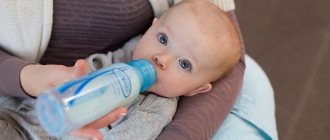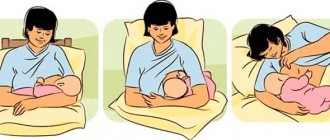Glossary
A newborn is a child from birth until the 28th day of life.
The end of the sling age (the upper limit of the wearing period) is the age at which either the child no longer needs to be carried, or it is already difficult for the mother to carry. The age at which babywearing ends usually ranges from one and a half to three years.
M-position – the position of the child’s legs and pelvis in a vertical position: the child’s knees are above the pelvis, the pelvis is deeply sunk and away from the mother. The sling supports the baby's hips and pelvis from knee to knee, the legs are free from the knees.
M-position
The pelvis is set aside - the baby’s pelvis is located further from the mother than the shoulders. If you look in profile, the child’s back is not strictly vertical, but is at a slight angle; the tightly attached pocket of fabric at the back of the head (or under the armpits) expands downward. The position is accepted by the baby naturally, or when the mother slightly brings the baby’s knees together, pushing them up.
The pelvis is away from the mother
Position of the baby in the sling
The baby in the sling is carried in the same positions as in the arms.
Positions “cradle”, “facing mother” and “on the hip” on the arms without a sling
The baby in the sling should be pressed quite tightly against the mother. In vertical positions, the child's pelvis and hips should be positioned symmetrically . The sling should be comfortable for both parent and child. The sling should be adjusted evenly. Wrinkles and sagging fabric reduce support, and over-stretched segments create uneven pull and can cause pressure and discomfort.
Why pick up your baby?
Contrary to popular belief, a child should be held as often as possible. This is due not only to the fact that he, who has just come into this world, needs attention and support like no one else. While in the mother's womb, the baby heard the beating of his mother's heart all the time and felt her warmth. Once cut off from this, the baby experiences stress.
The more often you hold your newborn in your arms, the more comfortable his stay in our world will become. In addition, very often it is the mother’s warmth and touch that can relieve tummy cramps in the baby.
Vertical position
The child is positioned at a height that varies according to the needs of the child and the parent. Typically, a sign of a well-fitted sling is that you can kiss the top of your baby's head or forehead.
In an upright position, the sling should provide support under the back of the head in the neck area, support for the back, pelvis and hips.
The head of children in a relaxed state and in children who do not yet know how to hold their head should not bend towards the chest and may be slightly tilted back.
Upright support in a sling
The head support fabric or cushion passes under the back of the head or over the head at ear level.
Supporting the head in an upright position
The head of children in a relaxed state and in children who do not yet know how to hold their head should not bend towards the chest and may be slightly tilted back. The bending of the baby's head towards the chest in a vertical position may be due to excessive tightening of the upper side of the sling. When adjusting the top of the sling, pay attention to the strip of fabric about 20cm from the top edge, not just the top edge.
Back. Until the child has learned to hold his back, and also in a child in a relaxed state (in sleep), the back should be rounded. This rounding allows the intervertebral discs to fully absorb the steps of an adult. Excessive tension of the fabric or straps in the child’s lumbar region and slightly above contributes to an unnaturally straightened position of the spine for an early age. An older child can independently straighten his back during periods of wakefulness. The baby's pelvis should be tucked toward the mother (as if the baby had his tail between his legs).
In this position, the child is vertically in the sling
The legs are spread at an angle that is comfortable for the child (usually 60–110 degrees; the angle is formed by the child’s hips). The knees are higher than the pelvis and rest against the mother. The toes of the feet “look” in different directions, or hang down freely. The sling evenly supports the baby's hips and pelvis from knee to knee in this natural position, with the legs hanging from the knees from the sling.
The angle between the thighs is 60–110 degrees, the vertical angle is 110–120 degrees
NB. The mother's legs can hug her when the child is already big enough.
Do not forcefully spread your legs wider than a comfortable angle. The sling should tightly towards the wearer. You can check this after winding is completed by removing the hands that supported the child during winding. If the baby in the sling has moved down or to the side by more than 3 cm, the pull is not strong enough.
When the sling is fully put on, the child is pulled in, a posture correction is necessary: an adult, taking the child by the shins, pushes his knees up, bringing them a little closer.
Posture correction: taking the child by the shins, push the knees up and bring them a little closer
The vertical position in the fetal position - with the legs hidden inside the sling - is recommended only for children with severe hypertension and premature infants (due to unstable thermoregulation). In this position, it is recommended to place the child's legs, bent at the knees, between the parent and the child to avoid pressure on the feet and the possibility of pushing them, as this puts stress on the child's back. It is unacceptable to place the feet under the child’s bottom. The disadvantages of the fetal position are the possibility of significant voids forming between mother and baby, which complicate the physiological placement of the child in the sling. Therefore, full-term infants without hypertonicity are recommended to be placed in a sling with legs outward from birth.
How to hold your baby during water procedures
Probably every parent is tormented by the question of how to properly hold a newborn while bathing. Very often, mothers and fathers are especially afraid of making a mistake when bathing. In vain. After all, during water procedures, water itself helps to hold the newborn! The parent can only support the baby's head.
Useful: How to choose the right pacifier and teach your child to use it?
With your left hand, gently support the back of the child's head: the baby's head lies on the wrist, and the palm can be placed on the child's shoulder. At this time, you can lift the baby by the lower back and butt with your right hand. This is not necessary, but young mothers feel better knowing that they are in complete control of the situation.
Later, when you get used to it and learn how to hold your baby correctly, you can play in the bathtub and turn the baby over onto his stomach, holding him under your chest with your hand.
Washing
You can wash your baby both in the bathtub and in the sink. The baby's head should be placed on the forearm, with the back and butt facing down. But some parents may find it more convenient to wash their baby when he lies tummy down. This pose is also acceptable.
It is important to remember that boys and girls are washed differently! A newborn girl is washed from top to bottom: from the vagina to the anus, so as not to cause infection. In boys, it is not recommended to retract the foreskin during hygienic procedures.
Horizontal position (cradle)
The active use of the cradle is due to the established wearing traditions in Russia.
In a horizontal position in a sling, the child is located diagonally in the fabric. The lowest point of the diagonal is the child’s butt, the highest is the head, the knees are also above the butt. The child is located at a height that is comfortable for the mother, half-sided towards the mother. The mother should always see the child's face, i.e. The face should not be under the chest, under the armpit, turned down, or covered with a cloth. In a horizontal position, the sling should provide support in the occipital part of the head, back, pelvis and hips.
Support in the cradle position
For beginners, it is recommended to support the baby's head in the crook of your elbow for at least the first week of wearing.
It is also necessary to support the head in the bend of the elbow while feeding a baby up to 3–4 months (the baby’s head can be either inside the sling or outside the fabric).
Supporting the head in the elbow during carrying and feeding
1-2 fingers of an adult should be placed between the child's chin and chest; the child's chin not be pressed against his chest. The position of the child resembling the letter “C” should be avoided.
Attention! Dangerous! C-position! In the first two photographs, the child is laid in a sling along the cloth, in the third - the top side is pulled over
Bend of the baby's head towards the chest in a horizontal position can also be caused by excessive tightening of the top side of the sling. To avoid the C-position, when adjusting, pay attention to the part of the sling that falls on the child’s shoulders and upper back. It is not recommended to tighten the top edge too much.
The head, shoulders and axis of the spine are on the same plane. In this case, the child’s head in the cradle position is located quite high, the child’s back is not horizontal, but runs almost at an angle of 30–45 degrees.
The child in the “cradle” is not located horizontally, but at an angle of 30–45 degrees. Head, shoulders, back form one line
The back is supported by fabric evenly along its entire length, maintaining physiological roundness. You should avoid transverse folds in the fabric in the area of the child’s neck and back, because with proper tension on the fabric, the folds will cut in. To support the baby, you should pull out only as much fabric as is required to support the body up to the top of the head, leaving excess fabric under the child's knees. Fabric supporting the head along the crown or crown and at ear level. The inner side of the sling passes between mother and baby. The child's legs are bent at the knees, raised and directed towards the stomach, the knees are above the pelvis. The sling supports the legs under the knees, the legs hang from the knees from the sling, a newborn in a horizontal position can be placed in the sling entirely, with the legs inside.
The baby's lower arm either goes under the adult's armpit, or both hands are placed on the baby's chest.
NOT RECOMMENDED for wearing in a sling in a horizontal position:
a) premature infants due to the increased likelihood of them having apnea (stopping breathing movements) in this position;
b) infants with diagnosed abnormalities in the development of the hip joint;
c) special (with deviations and developmental delays) children with breathing problems, suffering from epilepsy, with severe hypotonia, which does not allow them to turn their head during regurgitation, etc. ;
d) children with diseases that make breathing difficult (ARVI, etc.).
Attention: do not use the “cradle” as the only way to carry a newborn in a sling. The positions in the sling should repeat the various positions you and your baby are accustomed to in your arms.
Also, do not forget about the one-sided load on the body of the child and mother; alternating sides of wearing is mandatory!
Age restrictions
Indication of a specific age in instructions and recommendations does not take into account the individual developmental characteristics of each child. Therefore, the Association of Babywearing Consultants recommends focusing on the skills of each individual child. Below, each specific age is listed in accordance with the skills that a child should have for certain positions in a sling. If your child has reached the age specified in the instructions or recommendations, but does not yet have the appropriate skills, mastering a new position or a new carry should be postponed until the child develops this skill.
AGE
| SKILL | |
| 1 – 2 months | Most children lose their congenital tone; most children still cannot support their head and back. |
| 3 months | The child holds his head and begins to hold his back: in a position on his stomach, he holds his head and chest above a horizontal surface, begins to rise on his fists, and begins to roll over. |
| 4 – 6 months | Confident support of the back (developed back muscles), the child turns over, in the position on the stomach, support on outstretched arms, up to a position on all fours. |
| 6 months | The child tries to sit/sits independently. Independent sitting means that a child who is placed on a flat surface is able to sit on it for some time without support and not fall to one side. |
| 9 months | The child stands at the support. |
| 1 year | The child walks independently. |
Stages of formation of spinal curves and corresponding skills
From birth, you can carry your baby in horizontal positions (different versions of the “cradle”). A child weighing up to 3.5–4 kg can be placed in a sling entirely (with legs!).
From birth (if muscle tone allows), the baby can be carried vertically in the M-position with the legs outward in adjustable slings and wraps that allow the baby's shoulder girdle to be tightly pulled and provide head support.
From birth, you can carry the baby on the mother’s stomach with a shift toward the hip (“half-thigh”) in adjustable slings and wraps that allow you to tightly pull the baby’s shoulder girdle and provide head support.
From the age at which the child confidently holds his head and begins to support his back (usually 3-4 months), you can wear it on your hip. The Association of Sling Consultants recommends that from this stage of development you begin to carry your baby on your hip without a sling (with the baby’s back firmly secured). Also at this age, you can free the baby’s arms in a vertical position in front and on the half-thigh (the upper edge of the sling passes no lower than the child’s armpits).
From the age when the child makes attempts to sit up/sits independently (usually from 6 months), you can carry him in ergonomic backpacks and fast slings.
Hipsits are not classified as slings, and the Association of Sling Consultants considers wearing a hipsit safe only for children after 9 months (the child stands confidently against a support and begins to walk with support).
carrying a child on the back when the mother is confident in using a sling, the technique of wearing behind the back without a sling, and also provided that the mother feels the baby’s breathing: the baby’s nose should be at the level of the mother’s neck or higher.
Attention: carrying a baby on your back at the age of 0–3 months is recommended for experienced sling mothers, or should be mastered with the help of a sling consultant. It is safer to start mastering the back carry with an older child who is already holding his back or even sitting. To master the skill of back carrying independently, it is recommended to involve an assistant who can secure the child. For training and getting used to it, it is advisable to start carrying the baby on your back without a sling; it is more convenient to do this in a playful way.
Ergo backpack: design features
After devastating studies of the influence of kangaroo backpacks on the development of a baby, manufacturers of goods for children are seen to be unscrupulous, and often call carriers an ergonomic backpack (or sling backpack) that have nothing to do with physiology. Therefore, before purchasing, you should make sure that you have an ergo backpack. The following parameters indicate that the carrying is correct:
- A wide, rigid belt that fits at mom’s waist or just below. Kangaroos either do not have a belt fastening at all, or they are made in the form of thin belts. The belt is a very important thing, because it is the one that takes the weight of the baby, distributing it on the mother’s hips.
- Thick and wide shoulder straps, often padded with foam to reduce pressure. This feature, combined with a functional belt, prevents the straps from cutting into the shoulders even if the child is already heavy. If you use an ergo-backpack, the age of a toddler can be up to 3 years, while in a kangaroo even a one-year-old is noticeably difficult to carry.
- The back of the backpack is wide and has no narrowing in the butt area with cutouts for the legs. This ensures the correct position of the legs and the distribution of the weight load on the child’s hips, and not on the spine.
- The back material is soft, which allows you to give it the necessary C-shaped bend. The rigid back of the kangaroo forcibly aligns the children's spine, disrupting the formation of its natural curves.
photo from the site https://www.loveandcarry.com
Please note that if the design includes a hood, it is not intended to support the cervical spine. This is one of the key points in the question of at what age you can use an ergo-backpack. Even if the manufacturer claims that the model is intended for newborns, it is absolutely impossible to do without head support. The hood is designed to protect from wind or precipitation, as well as for cases when the baby has fallen asleep, but it does not support the neck.











